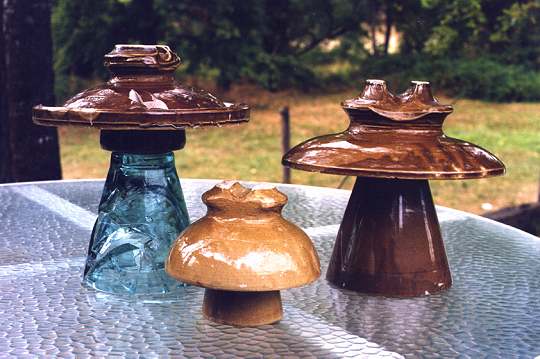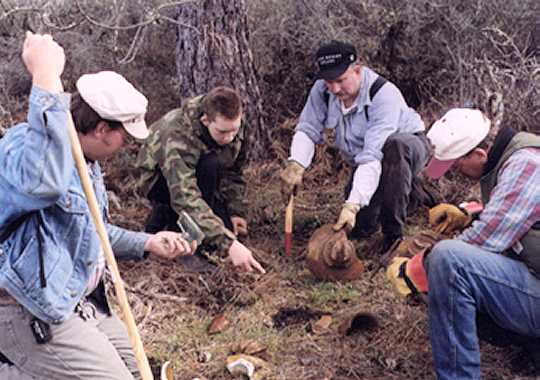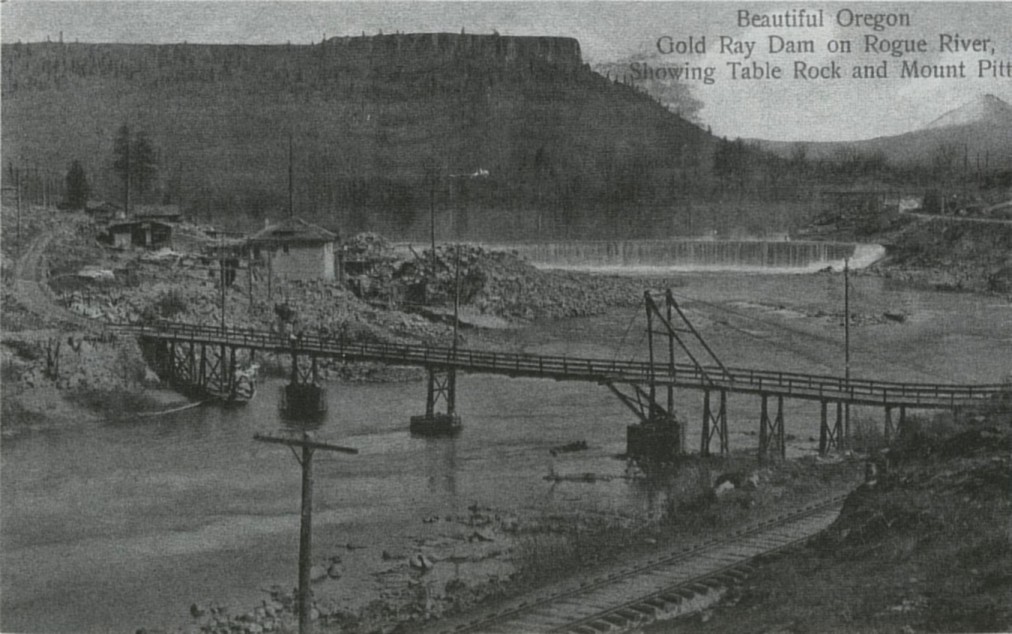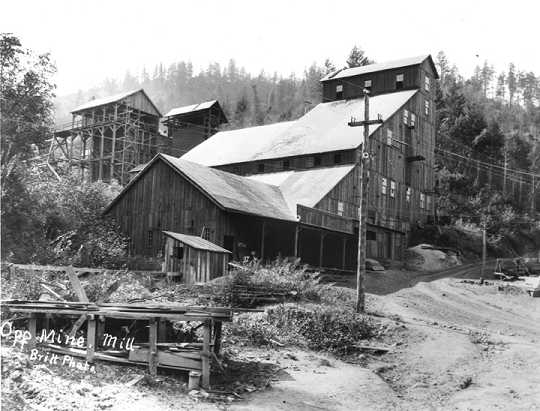Insulators Used by the Rogue River Electric Company
Story By Howard Banks Reprinted from "Crown Jewels of the Wire", June 2005, page 44
The Search
Late on a lazy, autumn afternoon in 1967 school teacher Charles Fox came to
my house all excited with news of a power line running up the side of a mountain
to the Granite Hill Gold Mine near Grants Pass, Oregon.
One of Chuck's fifth-grade students said he had been deer hunting with his
father on the mountain when they found an abandoned line with glass insulators.
Well, I hardly believed it. I mean, why would there be a power line in that
area? But I went along. We drove and drove up the mountain until I was ready to
say... " I could have told you so". But then, standing right alongside
the road was a single pole. There were no insulators there; but the very next
pole down the line had, lying at its base, three M-2795's.
Thus began my acquaintance with a power line that, thirty-eight years later,
I'm still walking, still hunting along, and still making some great insulator
finds.

Left to Right:
M-2795, U-964 & M-2842
In the Beginning
The Rogue River Electric Company owes its existence to the Alaska Gold Rush.
In 1900, a wealthy New Yorker named Colonel Frank H. Ray financed a trip to
Alaska for his brother, Dr. C.R. Ray, to check out some prospective gold mines.
When they didn't pan out, Dr. Ray telegraphed his brother that he was returning
empty handed. But Colonel Ray persuaded Dr. Ray to take a look at a gold mine in
Southern Oregon that he had heard about. And so it was that Dr. Ray purchased
the Braden Mine near the town of Gold Hill.
By 1902, the Ray's determined that the way to make the Braden Mine productive
would be to supply it with electrical power. Again with Colonel Ray's financing,
the brothers purchased property along the Rogue River from a man named Dan
Condor with the intention of building a dam to generate the needed power. But to
obtain enough money to finance the project, they sold stock on the New York
exchange under the name "Condor Water and Power Company".
Construction of a log "crib" dam began in the fall of 1902 . The
first power wasn't produced until December 7th, 1904. During that two year
period, the Ray's discovered that electricity, and not gold, would be the secret
of their success. By 1907, their Rogue River Electric Company supplied power not
only to numerous gold mines in the region, but also to the cities of Medford,
Jacksonville, Central Point, Grants Pass, Woodville (Rogue River) and Gold Hill.
Dam & Power Plant
Construction of the first dam on the Rogue River wasn't any more popular an
idea in 1902 than building a dam would be today. In the first year, someone
planted dynamite at a key site with the apparent intention of blowing the
project up. But the scheme was discovered before damage was done. When
completed, the dam was 17 feet tall and 350 feet long. Water was drawn off the North side of the
river to a small, 250 kilovolt generator. The generators were expanded to 750-K
in 1905. In 1972, when the plant was decommissioned, its production was 1250-K.
Throughout its nearly 70-year history, the power plant employed 1897 General
Electric generators operated by 1,600 feet of one-and-three-quarter inch rope.
The water turned a series of pulleys, which rotated at a speed of 360 rpm's,
which, through the use of the rope, turned the generators. If a rope broke,
power was off line until it could be spliced. Working at the Gold Ray Dam, as it
is known today, required skills unlike those needed at many other power plants.
Insulators Used
Perhaps because the Colonel and Doctor Ray were from New York, they purchased
their insulators from Fred M Locke. No matter where you find traces of their
lines today, the insulators invariably will be Locke's.
An 18 mile stretch of one Rogue River Electric Company line from Grants Pass
to the Green Back mine in Northern Josephine County was outfitted almost
exclusively with M-2842's. Found in smaller numbers along that route were CD
286's, M-2795's and U-964's. The 286's and M-2795's were used in a few short
stretches. The U-964's, on the other hand, were found only sporadically, leading
me to speculate they were a replacement insulator.
The Greenback Mine was one of the largest hard rock mines in Southern Oregon,
producing an estimated $1,000,000 in gold at the time when gold was only worth
$16 per ounce. The mine's 40-stamp mill was operating with electric power by
1905.
A three-mile long branch line that ran to the Granite Hill Mine used M-2795's
almost exclusively. These were the insulators we originally found in 1967. But
even then, we only recovered seven or eight specimens. Many insulators were
broken. But most were simply no where to be found.
Where did the rest go? In 1998, I found a number of fragments at a nearby
gold mine that wasn't operated until the Great Depression of the 1930's. By
then, the power line had been out of service for decades. Why were insulators
gathered there? It's speculation, but my guess is that salvaging insulators,
wire and hardware off the old line was more profitable than mining gold. Would
someone re-use obsolete insulators? Even during the depression? The mystery
remains unsolved.
But the M-2795's were an obsolete insulator even when the line to the Granite
Hill Mine was erected in the 1905-1907 period. The glass and porcelain two-parters
were being replaced in California by 1904 when it was discovered that electrical
leakage would melt the sulfur cement that held the two parts together. The
insulators were self destructive. The molten sulfur would fall onto dry grass in
the summertime, setting the grass on fire, endangering the poles.

Bill Ostrander, David Banks, Ken Kline and Mid Norris
dig up broken pieces of
M-2842's and M-2795's
Why were these insulators used in Oregon three years after their failure in
California? Maybe someone thought they would work better in Oregon's cooler
climate? Or, maybe Fred Locke offered the Rogue River Electric Company a great
deal on unsold insulators still in stock? The M-2795's used on this section of
the line were production dated in December of 1900, some five years before they
were installed.
Elton Gish in "Fred M Locke A Biography" wrote that some of the
M-2795's were reportedly removed from the lines in California and shipped to
Hawaii. Perhaps others were sent to Oregon. The timing, 1904, would be perfect.
The Granite Hill Mine closed in 1908, after producing an estimated $75,000 in
gold. At its peak, it operated a 20-stamp mill.
The Green Back and Granite Hill sections of the power line are the best known
to insulator collectors. The stretch runs through mountainous terrain that
remains largely undeveloped. Had it not been for the construction of a modern
long distance power transmission line by Pacific Power and Light Company over
the same right-of-way, the M-2842's might have been common today. But
construction of the line in the 1950's virtually wiped out the historic line
altogether.
I can only recall finding one undamaged M-2842 in the 1960's. And that is
stretching the truth. Chuck Fox found a M-2842 that had been held together with
sulfur cement. Because of the soft cement, he was able to remove the broken base
from the unbroken top, and replace it with an unbroken base.
But because most M-2842's are held together with portland cement, we weren't
patient enough in the 1960's to piece the insulators together. After all, there
were just damaged porcelain insulators, and what we wanted back then was
"glass".
Glass insulators were used on other sections of the line. A picture of one
mine (pages 50-51) served by the Rogue River Electric Company shows glass on the
poles. The insulators appear to be CD 286's. One CD 287 was found near the
location of the line, but its use on the line can't be confirmed. Neither can
the discovery of a U-955, one of only two examples known. Found in the region,
its use by the Rogue River Electric Company is plausible.
The Rogue River Electric Company also advertised telephone and telegraph
services. Standing poles that remain from original construction, when found,
contain two side pegs per pole. Generally, the small communications insulators
were U-39's and U-611-A's. Very rarely, U-192-A transpositions were used.
References:
Fred M. Locke, A Biography, by Elton Gish, Infinity Press, 1994.
Southern Oregon Historical Society, Medford, Oregon.

1909 era postcard showing Gold Ray Dam. The dam and power house remain today;
but the bridge in the foreground is long gone.

Famed photographer Peter Britt took this picture of the Opp Mine near
Jacksonville, Oregon.
Six transmission insulators on the pole in front of the building appear to be CD
286
Fred M. Locke's. A short crossarm located where the circle is painted on the
pole
contains two porcelain insulators. Below that are two side pegs containing
unidentifiable glass insulators.
| 